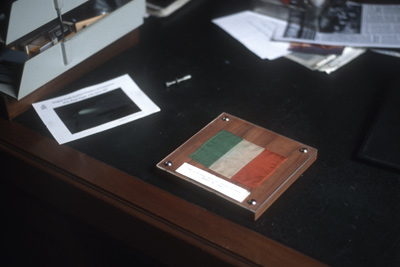![]()
![]()
![]()
![]()
![]()
.
...
...
Accidental Journey
A Farmer's Almanac
Surface of
... Last Scatter
Song of Childhood
Twenty-Seven
... Kilometres
Darkness
Tailspin
Endlessness
Feuilleton
The Irish Flag which was carried
on board APOLLO 11 1969
[Photograph | Tim O'Riley]
[click on the images to see more]![]()
I arrived at Dunsink Observatory for the first time to be met by an astrophysicist, Colin Melody, who despite being hard at work studying gamma ray bursts from deep space, was kind enough to show me around. We toured the spaces that house the telescopes and various rooms that are used for study, lectures, the library, and saw, among other things, Hamilton's folding desk on which much of his correspondence and papers may have been written. Colin then showed me into a room on the ground floor which, at first glance, looked in a state of mild disarray. The shutters were closed and in the half light, I could see things piled up everywhere: books, cardboard boxes, papers, countless files stacked precariously, cameras, slides and slide projectors, a game of Monopoly, a telescope and other scientific sundries, and intriguingly, numerous models of spacecraft (Soyuz, Voyager, and so on), most of which were now in a rather forlorn state. Colin later told me that the room had been previously occupied by William Dumpleton, a long serving member of the observatory staff who had recently passed away.
As my eyes grew accustomed to the light, Colin told me of a rather unusual but
prized object held in the observatory's collection. Disappearing for a few moments,
he returned with a small wooden plaque on which was mounted an Irish
flag, about 14 by 10 centimetres in size. It was held in place under a piece
of glass and modestly labelled with the following legend:
The Irish Flag which was carried on board APOLLO 11 1969.
This very flag had apparently travelled aboard the famous spacecraft and orbited
the moon in the command module while Neil Armstrong and Buzz Aldrin had walked
on the Moon for the first time in human history. It was unclear how this extraordinary
memento had found its way to Dunsink but for some reason, this did not seem important
at the time. The third astronaut on the Apollo 11 mission was Michael Collins
who orbited the moon alone for almost 22 hours, travelling to the far side and
back while his colleagues made their own history. As he traversed the moon's
far side in radio silence for 48 minutes of each orbit, Collins was cut off from
all and any human contact. I was curious about this state of solitude and what
might have crossed his mind as he moved out of range, the Earth no longer visible.
I have since tried to find out more about the flag's extraordinary journey and its the trajectory after returning to earth. The Dublin Institute for Advanced Studies, which is responsible for the observatory, apparently had some input into several research projects that went to the moon with the Apollo missions. This may have gone some way to explaining its presence at Dunsink but it remains, to me at least, a compelling, mysterious and uncertain relic.
![]()
![]()
